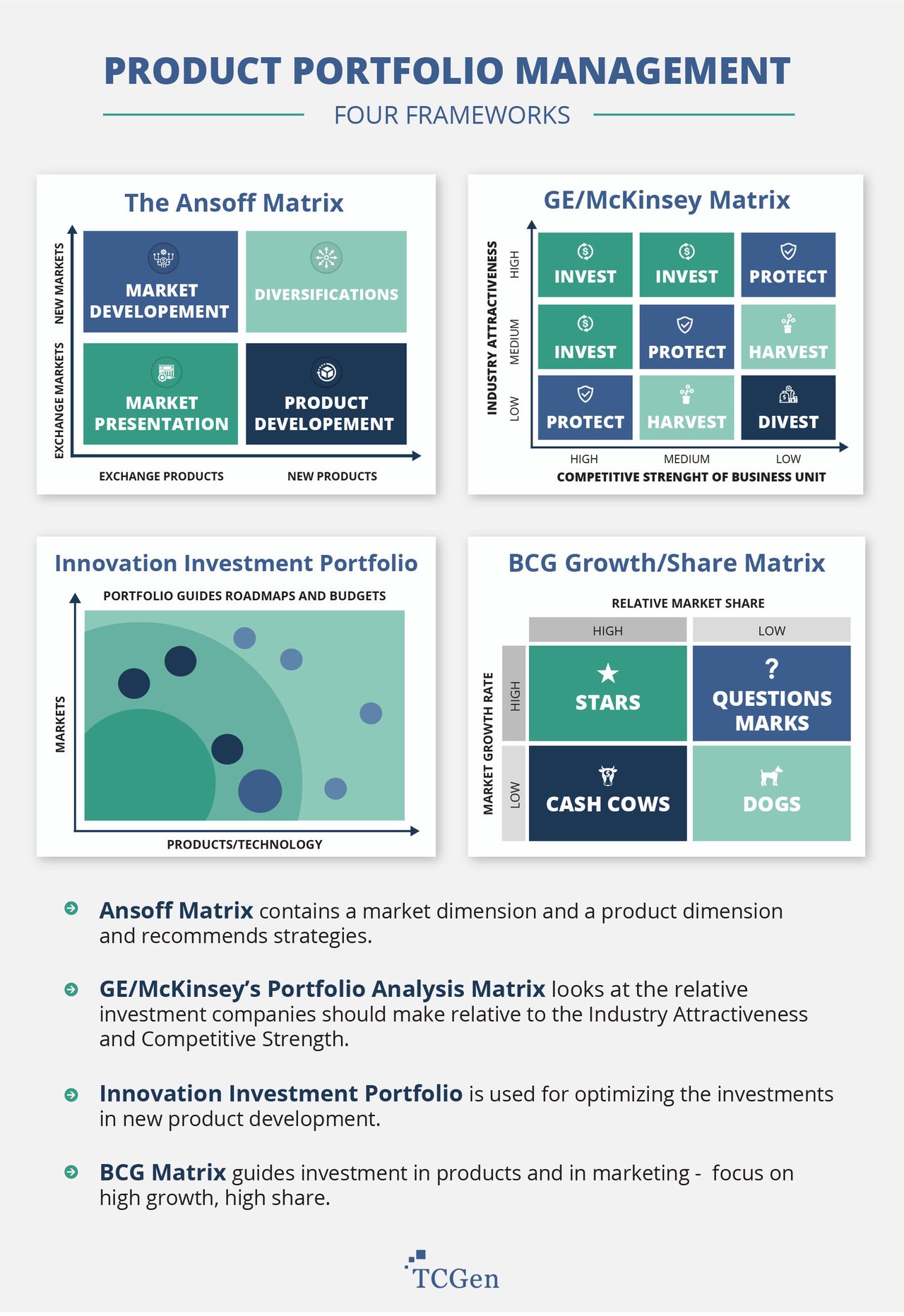Product Portfolio Management Consulting
TCGen’s Product Portfolio Management Consulting helps executives deliver on product development investments.
Trusted by these brands and organizations














TCGen’s Product Portfolio Management Consulting helps executives deliver on product development investments.
What is Product Portfolio Management (PPM) Consulting?
Product Portfolio Management Consulting services help organizations optimize their project and product management (PPM) processes to meet strategic objectives. These services offer valuable expertise and guidance in various areas, including:
- Investments and resource allocation in NPD
- Scaling from a single product to families of products
- Product Innovation and transformative products
- Creating a clear business strategy that links with product roadmaps and budgets
- Having the right mix of products with the correct pricing
- Superior product lifecycle management

We can help you optimize your Product Portfolio while improving innovation and maximizing NPD investments.
TCGen’s Product Portfolio Management expertise addresses a range of problems…
Companies accelerating beyond the start-up phase are beginning to create new products, including derivatives and spin-offs, and entirely new ideas representing the future. They often struggle to scale and sometimes miss opportunities because they don’t actively manage their product portfolio, and concepts are undeveloped. Typically, they don’t place a set of selective bets outside of the core products.
Other companies, including those transitioning from a few products in the marketplace to a small handful of offerings within a specific business unit, face the challenge of managing these concepts over time, moving them into the pipeline, and ultimately into the marketplace. In such scenarios, our product portfolio management tools can provide significant benefits. These tools enable organizations to effectively manage their product portfolio, streamline the workflow, and gain the necessary permissions to take risks in pursuing innovative product initiatives. By leveraging our expertise and tools, companies can navigate the complexities of product development and successfully bring their offerings to market.
Some companies find themselves caught between unmanageable growth and untenable stagnation. Striking the right balance between supporting core offerings and experimenting with bold, transformational ones is fraught with technical and market risks. A Harvard Business Review piece found, “Companies that allocated about 70% of their innovation activity to core initiatives, 20% to adjacent ones, and 10% to transformational ones outperformed their peers, typically realizing a P/E premium of 10% to 20%.” Growing tech companies tend to invest fewer resources than expected in the core, stimulating innovative solutions outside of it.
Too many successful companies create a hostile environment for new product concepts, suffocating possible home runs with indecision. However, having a superior Product Portfolio Management process, including adequate resource management and ideation, allows larger companies to nurture and prioritize the best ideas – the concepts that will enable your company to sustain its success.
Tie Strategy to Program Investments
Select the Best Ideas
Improve Your NPD Performance

Why Work With A Product Portfolio Management Consultant?
You’re probably facing one of these common problems:
- You are failing to commercialize transformative products effectively
- Product lines don’t tie to corporate strategy
- Unclear criteria for selecting projects – loudest voice wins & too many pet projects
- Fuzzy decision-making around product development investments
- Poor product lifecycle management resulting in sales decline
- Product portfolio has a poor balance between cash cows and offerings in new markets
Product Portfolio Management Consulting solves these problems plaguing CEOs, Heads of Strategic Planning, Chief Marketing Officers, Product Managers, and other new product development stakeholders.
These executives typically want assistance with Product Portfolio Management Strategy (PPM), Product Portfolio Analysis, resource allocation, NPD investment strategy, templates for product roadmaps, managing existing products vs. new products, lifecycle management, visualizing their project portfolio, and project prioritization. Note: Product Management Consulting experts can do this work as well and also work at the discrete product level.
Whatever the desired outcomes, whether it’s increased market share for existing products, better synergy between individual products, or more effective practices for real-time Product Portfolio Management (PPM), Product Portfolio Management Consulting can help you meet your business needs.
Benefits of Product Portfolio Management Consulting

Our clients have reported measurable improvements in performance following a Product Portfolio Management Consulting engagement. Typical results include:
- Improving program profitability and predictability
- Clarifying the tie between programs and business strategy
- Ensuring that a steady stream of new ideas gets made and sold
- Enhancing the effectiveness of NPD investments
- Maximizing the revenue from in-market products (lifecycle management)
- Improving the effectiveness of product portfolio managers
TCGen – What We Do and How to Engage
Although each engagement is unique, most are variations of these types.

“We’re making better decisions, faster”
— Apple Executive
- Schedule a no-obligation call. Book some time with us, and we can find out how we can help you.
- We will write it up. We will describe what we learned and suggest options for working together. These conversations may result in a proposal for your consideration.
- Kick-off Project. We will work with you to formulate a tailored kick-off to initiate the engagement.
TCGen’s Approach to Product Portfolio Management Consulting
We have developed methods for de-mystifying the front end of product development. And we have implemented them with blue chip companies such as Apple, BOSE, Cisco, Mozilla, and Roche. We have helped companies reduce the negative impact of out-of-date, declining products by coordinating lifecycle management with new product development. Our expertise in product portfolio management, combined with automation, has helped these firms converge quickly and reliably on the best opportunities to develop winning products that meet customer needs.
TCGen’s approach includes:
- A lightweight process that manages your day-to-day decisions that move and filter concepts as they make their way toward the pipeline
- A yearly strategic planning process for product innovation.
- A methodology that aligns the Board, the CEO, Business Development, and the rest of the C-Suite.
Read more about our Product Development Consulting services here.
Regardless of the specific consulting area, TCGen’s approach typically begins with a thorough assessment of your organization’s needs and follows it with focused training for team members and their managers:
- We first highlight the pain points in your portfolio.
- Then, we agree on goals and KPIs to improve product portfolio management, divided between new and in-market products.
- We then identify a small number of the most effective levers of improvement.
- We associate each of these Product Portfolio Management levers with a metric.
TCGen’s Product Portfolio Management Consulting Case History
TCGen’s approach to Product Portfolio Management helps teams optimize a critical resource: your company’s brightest ideas.
BOSE
- As chief engineer at BOSE, John Carter managed the development of products such as the BOSE® Wave® Music System and Noise-Cancelling Headphones, enjoyed by millions of customers worldwide. With over 25 years of consulting experience, John has developed expertise in product portfolio management and picking winners.
ROCHE
- We helped the healthcare giant with PPM by clarifying roles in the fuzzy front end. We used an experience-based approach to tie a corporate vision to a product portfolio, translating into product roadmaps and budgets.
The TCGen Difference
TCGen’s approach to Product Portfolio Management Consulting differs from the others because we listen. We drive deeply into the culture and the organization’s challenges, including the management and the development teams. Our Project History approach captures the voices within your organization and enables you to learn from the past as you imagine your future.
In a dialog with senior leadership, we define the key results you want to achieve. We then craft a customized approach to your Product Portfolio Management Consulting engagement.
We do not believe that “one size fits all.” Our Product Portfolio Management Consulting engagements enable you to select only the best approaches for you. Too many consultants complicate processes to no end. We’ll help you implement only the approaches that make a difference.
Consulting Options for Product Portfolio Management Consulting
There are several ways to enhance your organizational capability when exploring consulting options based on your business requirements. With TCGen, you can hire a new person with the product manager capability, or you could use a contractor, and we could help structure the organization or recommend job descriptions. TCGen focuses on process consulting services, which involve a comprehensive analysis of inbound and outbound marketing to identify improvement in innovation or execution speed. Furthermore, TCGen can help create a strategic product process to help you select and find the best ideas for your operational workflows to enhance efficiency and productivity. For organizations seeking to outsource their portfolio management strategy fully, renowned firms like Boston Consulting Group (BCG) or McKinsey can be engaged to leverage their large teams to provide research and industry insights, albeit at a higher cost.
We do not believe that “one size fits all.” Our Product Portfolio Management Consulting engagements enable you to select only the approaches that work for you and your portfolio of products. Too many consultants complicate processes to no end. We’ll help you implement only the approaches that make a difference in managing your successful product portfolio. Our focus is on practical solutions that align with your needs, enabling you to make informed decisions, optimize timelines, and create value within your organization. By tailoring our consulting services to your unique requirements and objectives, we ensure that our partnership drives meaningful outcomes and enhances your ability to achieve sustainable growth and value creation.
TCGen Owner and Principal
Nolan Myers
Nolan Myers is the owner and Principal Consultant of TCGen, where he helps organizations accelerate innovation, improve product execution, and deliver better products to market faster. A Harvard-trained computer scientist, Nolan has led teams that created products used by millions — from an education platform adopted by half of California’s public schools to a digital publishing platform powering content workflows at McGraw-Hill, Pearson, Starbucks, and McDonald’s.
At TCGen, Nolan partners with leaders to strengthen product strategy, execution, and speed to market. TCGen’s clients rely on its proven frameworks to cut time to market, scale product delivery, and embed innovation practices that stick.
A lifelong musician and technologist, Nolan explores how art, science, and teamwork combine to create exceptional products. He lives in the Bay Area, where he spends his time trying to stay fit, cooking, and studying how AI can amplify human creativity.

